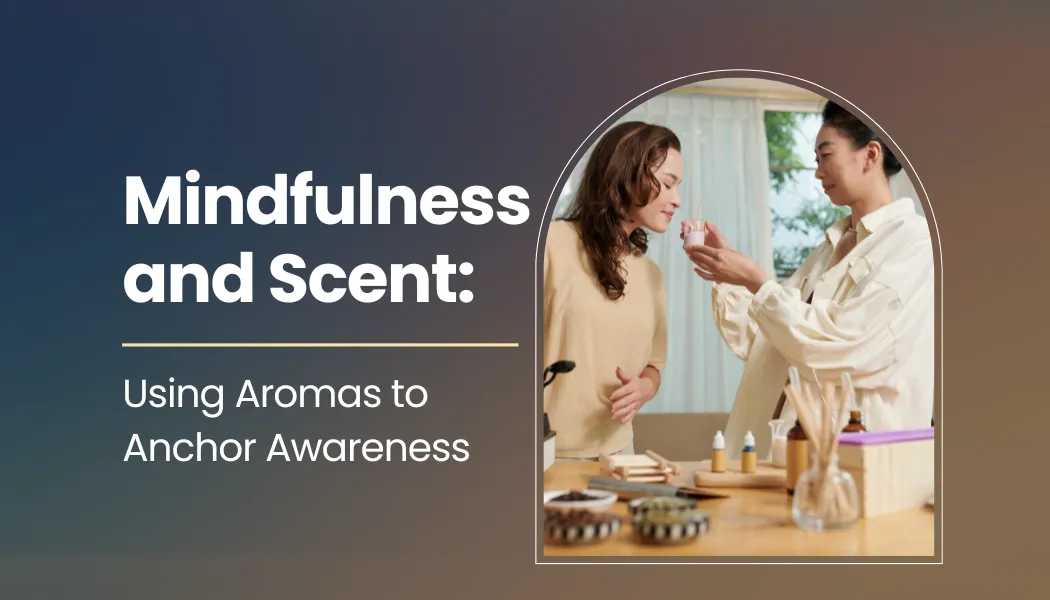When people think about mindfulness, the first things that come to mind are often meditation, breath awareness, or simply being present in the moment. Yet, one of our most powerful senses—our sense of smell—is frequently overlooked. Scent is unique because it is deeply tied to memory and emotion. A single whiff of freshly baked bread may transport you to your grandmother’s kitchen, while the smell of ocean air might instantly evoke calm and freedom. This immediate and often unconscious effect makes scent a profound anchor for mindfulness practice.
In today’s fast-paced, overstimulated world, finding simple yet effective tools for grounding ourselves is essential. Aromas can serve as these tools. Unlike sight or sound, which require deliberate attention, scents often bypass analytical thinking and connect directly to the brain’s emotional and memory centers. By intentionally engaging with scent, we can enhance mindfulness, deepen relaxation, and cultivate presence in everyday life.
This article explores the fascinating connection between scent and mindfulness. We’ll dive into the science of smell, its influence on emotions, and how to incorporate aromas into mindful living. From practical techniques using essential oils and natural fragrances to cultural traditions that have honored scent for centuries, we’ll uncover how aromas can serve as gentle yet powerful anchors for awareness.
Table of contents
- The Science of Scent and Mindfulness
- Cultural and Historical Roots of Scent in Mindfulness
- Practical Ways to Use Scent as a Mindfulness Anchor
- Aromatherapy and Emotional Regulation
- The Neuroscience of Anchoring Awareness with Scent
- Challenges and Misconceptions
- Integrating Scent into Everyday Life
- Personal Stories: The Transformative Power of Scent
- Conclusion: Anchoring Awareness Through the Subtle Power of Scent
The Science of Scent and Mindfulness
To understand why aromas are so effective in mindfulness, we need to explore how our sense of smell works. Unlike other senses, olfactory signals travel directly to the brain’s limbic system—the region that processes emotions, memories, and behaviors. This unique pathway explains why scents often evoke vivid memories and feelings without conscious effort.
For example, studies show that lavender reduces anxiety by influencing the parasympathetic nervous system, slowing heart rate, and calming the mind. Similarly, peppermint is associated with increased alertness and improved cognitive function. This connection between scent and physiological responses makes it a natural ally for mindfulness practices.
In a way, aromas act as “shortcuts” to presence. Instead of wrestling with wandering thoughts or distractions, a simple inhalation of a chosen scent can help ground awareness in the present. This makes scent-based mindfulness particularly helpful for beginners or those who find traditional meditation difficult.
Cultural and Historical Roots of Scent in Mindfulness
The mindful use of scent is not new—it has been woven into human culture for centuries. Ancient civilizations understood the profound role of aromas in spiritual and emotional well-being.
- India and Ayurveda: Aromatic oils like sandalwood, rose, and jasmine were used in meditation and healing rituals to balance the mind and body.
- China: Incense burning was integral to Buddhist practices, believed to purify the space and calm the mind for meditation.
- Japan: The art of Kōdō, or “the way of fragrance,” treated the appreciation of incense as a meditative ritual. Participants would savor each scent with mindful attention, similar to a tea ceremony.
- Middle East: Frankincense and myrrh played central roles in spiritual ceremonies, symbolizing purification and connection to the divine.
- Ancient Greece and Rome: Aromas were used in healing, worship, and relaxation, recognizing their effect on both mood and spirit.
By understanding these traditions, we can see that mindfulness with scent is not a modern invention but rather a rediscovery of timeless wisdom.
Practical Ways to Use Scent as a Mindfulness Anchor

1. Mindful Breathing with Aromas
Choose a calming scent such as lavender, eucalyptus, or sandalwood. As you inhale, focus entirely on the fragrance. Notice its layers: is it sharp, earthy, sweet, or floral? Pay attention to how it feels in your body. Does your chest expand? Do your shoulders relax? This simple act of mindful smelling combines breath awareness with sensory focus, grounding you in the moment.
2. Creating Scent Rituals
Rituals help the mind shift into presence. You might light incense before journaling, use a few drops of essential oil before meditation, or burn a scented candle during evening reflection. Over time, your brain will associate the aroma with calm awareness, making it easier to enter a mindful state.
3. Scent and Gratitude Practice
Pick a scent linked to a positive memory—perhaps vanilla reminding you of family baking, or pine evoking hikes in nature. As you breathe it in, reflect on the gratitude connected to that memory. This bridges mindfulness with appreciation, reinforcing positive emotions.
4. Mindful Walking with Nature’s Scents
When outdoors, pause to notice natural aromas: the freshness of rain-soaked soil, the sweetness of blooming flowers, or the crispness of winter air. Mindful smelling in nature fosters a deep connection with the environment and encourages presence.
5. Bedtime Scent Meditation
Certain scents prepare the body for rest. A lavender sachet by your pillow or a chamomile-infused mist can turn bedtime into a mindful ritual. As you breathe in, let the fragrance anchor you in stillness, easing the transition into sleep.
Aromatherapy and Emotional Regulation
Aromatherapy has long been recognized for its impact on emotional well-being. By deliberately choosing scents, we can regulate mood and guide awareness:
- Lavender: Calms the nervous system, reduces anxiety, and promotes restful sleep.
- Citrus (orange, lemon, bergamot): Uplifts mood, fosters optimism, and refreshes the mind.
- Peppermint: Invigorates, sharpens focus, and supports mental clarity.
- Rose: Enhances feelings of compassion, love, and openness.
- Sandalwood: Grounds the spirit, supporting deep meditation and contemplation.
By engaging with these scents mindfully, we don’t just experience pleasant aromas—we learn to listen to our bodies and emotions with awareness.
The Neuroscience of Anchoring Awareness with Scent
Recent research in neuroscience provides evidence for the role of scent in mindfulness and emotional regulation. Functional MRI scans show that olfactory stimuli activate the amygdala and hippocampus—areas tied to emotion and memory. This means aromas don’t just affect how we feel; they also shape how we remember experiences.
When mindfulness practitioners pair scents with meditation or gratitude exercises, they effectively “encode” the state of presence into memory. Later, encountering the same scent can act as a trigger, bringing back the calm and focus from earlier practice. This is why scent is sometimes described as a “portal” to awareness—it holds the power to bring us back to the present in seconds.
Challenges and Misconceptions
While mindfulness with scent is powerful, it’s not without challenges. Some people may experience sensitivities or allergies to strong fragrances, making careful selection important. Opting for natural essential oils or unscented meditation practices when needed is a good alternative.
Another misconception is that mindfulness requires exotic or expensive aromas. In reality, even the simplest scents—fresh coffee, herbs from the kitchen, or rain on the pavement—can be powerful mindfulness anchors. The key lies not in the complexity of the fragrance but in the depth of our attention.
Integrating Scent into Everyday Life
Mindfulness with aroma doesn’t need to be limited to meditation sessions. It can be woven seamlessly into daily routines:
- Morning Ritual: Start your day with citrus oils for energy and positivity.
- Work Focus: Keep peppermint or rosemary nearby to sharpen concentration.
- Stress Relief: Use lavender or chamomile during breaks to reset your mood.
- Cooking: Engage with the aromas of food preparation—notice the earthy smell of garlic, the spice of cinnamon, or the freshness of herbs.
- Bathing: Add essential oils to your bath and let the steam amplify mindful breathing.
When we pay attention to everyday scents, even mundane tasks become opportunities for awareness.
Personal Stories: The Transformative Power of Scent
- Anna, a teacher, struggled with stress until she began using lavender essential oil before bed. Over time, the scent became a signal for her body to relax, transforming her evenings into moments of mindful rest.
- David, a busy professional, integrated peppermint oil at his desk. Each time he inhaled it, he paused to reset his thoughts, reducing burnout and enhancing focus.
- Leila, a student of meditation, found sandalwood incense deepened her practice by helping her quiet mental chatter.
These stories highlight how small, consistent practices with scent can make mindfulness more accessible and sustainable.
Conclusion: Anchoring Awareness Through the Subtle Power of Scent
Mindfulness is ultimately about presence—about returning to the here and now. Scent, with its unique neurological and emotional power, offers us an often-overlooked yet incredibly effective path to this presence. Whether through essential oils, natural aromas, or cultural traditions, engaging with scent mindfully allows us to connect with our emotions, memories, and environment in profound ways.
By weaving aroma into our daily lives, we transform ordinary moments into rituals of awareness. The smell of coffee becomes a morning meditation, the fragrance of lavender a doorway to rest, and the scent of rain a reminder of nature’s beauty. In this way, mindfulness ceases to be an abstract practice and becomes embodied—something we live, breathe, and savor.
As you read this, perhaps take a moment: inhale deeply. Notice the air around you. Is there a scent? Sweet, earthy, sharp, or faint? Whatever it may be, let it anchor you here, now, fully present.
